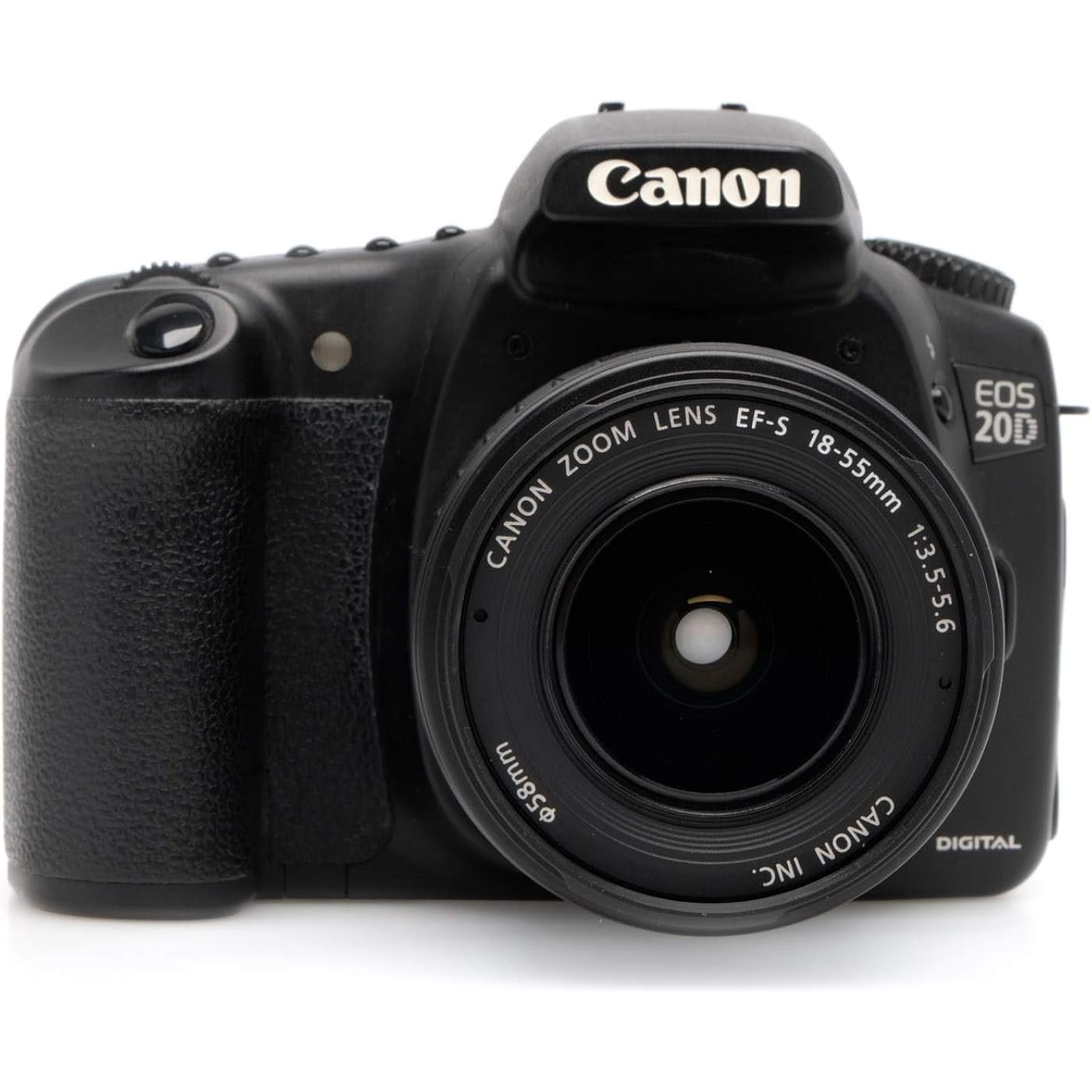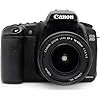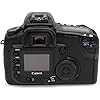


Buy Now, Pay Later
- – Up to 36-month term if approved
- – No impact on credit
- – Instant approval decision
- – Secure and straightforward checkout
Ready to go? Add this product to your cart and select a plan during checkout.
Payment plans are offered through our trusted finance partners Klarna, PayTomorrow, Affirm, Afterpay, Apple Pay, and PayPal. No-credit-needed leasing options through Acima may also be available at checkout.
Learn more about financing & leasing here.
Returnable until Jan 31, 2025
To qualify for a full refund, items must be returned in their original, unused condition. If an item is returned in a used, damaged, or materially different state, you may be granted a partial refund.
To initiate a return, please visit our Returns Center.
View our full returns policy here.
Recently Viewed
Features
- Powered by rechargeable BP-511A 1390mAh battery pack
- Store images on CompactFlash memory card
- Includes 18-55mm (3x zoom) f/3.5-5.6 autofocus lens, EF mount compatible with all Canon lenses in EF and EF-S lineup
- 8.2-megapixel sensor captures 3504 by 2336 pixel JPEG or RAW images
- Direct printing with PictBridge printers
- 8.2-megapixel sensor captures 3504 by 2336 pixel JPEG or RAW images
- Includes 18-55mm (3x zoom) f/3.5-5.6 autofocus lens, EF mount compatible with all Canon lenses in EF and EF-S lineup
- Direct printing with PictBridge printers
- Store images on CompactFlash memory card
- Powered by rechargeable BP-511A 1390mAh battery pack
Description
The perfect EOS for advanced amateurs and professionals alike, the EOS 20D sets new standards in its class. Featuring an all-new 8.2 MP CMOS sensor, a second-generation DIGIC II image processor, 5 fps performance for up to 23 consecutive frames, and a 0.2 second start-up time, the EOS 20D is designed to capture richly detailed, perfectly exposed images with speed formerly found only in cameras several times the price. Other features include a top shutter speed of 1/8,000 seconds, flash sync at 1/250, a new high-precision nine-point AF system, a built-in multicontroller for fast focusing point selection, and a refined magnesium alloy body for rugged, go- anywhere photography. Compatible with not only Canon's new EF-S lenses but the entire EOS system of lenses and flashes, the EOS 20D is a professionally featured camera with a consumer price tag. From the Manufacturer The perfect EOS for advanced amateurs and professionals alike, the EOS 20D sets new standards in its class. Featuring an all-new 8.2 MP CMOS sensor, a second- generation DIGIC II image processor, 5 fps performance for up to 23 consecutive frames, and a 0.2 second start-up time, the EOS 20D is designed to capture richly detailed, perfectly exposed images with speed formerly found only in cameras several times the price. Other features include a top shutter speed of 1/8,000 seconds, flash sync at 1/250, a new high-precision nine-point AF system, a built-in multicontroller for fast focusing point selection, and a refined magnesium alloy body for rugged, go-anywhere photography. Compatible with not only Canon's new EF-S lenses but the entire EOS system of lenses and flashes, the EOS 20D is a professionally featured camera with a consumer price tag. 8.2-Megapixel CMOS Sensor Canon's all-new large-area CMOS (complementary metal oxide semiconductor) sensor captures images with exceptional clarity and tonal range, and offers the most pixels in its class. This second-generation APS-C-size sensor (22.5 by 15.0mm) has the same 3:2 ratio as film cameras, enabling an effective angle of view that is 1.6 times the normal EF lens focal length. The EOS 20D has an extensive ISO range (from 100 to 1600 plus ISO 3200 in extended mode), and the sensor features a newly developed set of narrow-gap microlenses and noise-reduction circuits to improve performance at high ISOs and optimized photodiode configurations for improved performance at all ISOs. This results in larger, clearer, sharper, and more detailed photographs right from the start. Second-Generation DIGIC II Image Processor The EOS 20D benefits from Canon's in-house development: The DIGIC II image processor was developed originally for the EOS-1D Mark II and enhances every aspect of image capture. Information captured by the CMOS sensor is processed and assembled into images of exceptional quality by this new image processor. With the DIGIC II image processor on board, photographers can expect precise, natural colors and spot-on white balance in any number of lighting situations. Through sophisticated signal processing algorithms, the DIGIC II image processor even accelerates all aspects of image capture, while consuming less energy than other processors. Every Function Optimized for Speedy RAW and JPEG Capture The EOS 20D has been designed to capture images with speeds that had been reserved for professional-level cameras. Whether it's the 0.2 second start-up time, the high-speed mirror drive, the class-leading 65 microsecond shutter release lag time, or the predictive AF focusing at speeds up to 5 frames per second, the EOS 20D will amaze and delight photographers who don't want to wait for their camera when they're ready to shoot. The 20D's CMOS sensor allows four-channel high-speed data readout, and the DIGIC II image processor processes the data quickly, writing files to the CompactFlash card faster, and allowing continuous shooting for up to 23 frames (JPEG Large/Fine) with significant reductions in buffer clearing times. JPEG or Simultaneous RAW+JPEG Whenever you shoot the EOS 20D, you can choose to have it record RAWs or JPEGs alone, or in RAW plus JPEG formats simultaneously. The JPEG recording format is ideal for purposes such as Internet image transfers that require reduced file sizes. Canon's proprietary RAW (.CR2) format, on the other hand, employs lossless compression to ensure the highest possible image quality, and is recorded at 12 bits per pixel to provide a wider range of tones and superior detail in bright highlights and deep shadows when compared with JPEG files. RAW files must be processed before they can be opened in your computer's image-editing software. This conversion process typically takes only a few seconds using the dedicated driver software, which will convert the RAW file into a standard 8-bit-per-channel JPEG or TIFF file, or for maximum tonal range, a 16-bit TIFF. There are six selectable settings for in-camera JPEG image quality, when CF card space is at a premium. Expansive Sensor Array for Easier Composition The EOS 20D has a newly developed high-precision nine-point AF system for speedy and accurate focusing in any situation. An improved focusing screen with precision matte finish enables brighter and easier manual focus. A newly developed multicontroller, conveniently located on the back of the camera for thumb-controlled action, allows the photographer to instantly choose any of the nine focus points or direct the camera to choose them automatically. Focusing points are positioned in the viewfinder in a wide diamond-shaped array, allowing the user to achieve focus quickly in numerous compositions and situations. Features Formerly Offered Only in Canon's Pro Cameras Allow for More Fine-Tuning Photographers will find their options for color settings greatly expanded in the new EOS 20D. Taken directly from the EOS-1D Mark II, the white-balance compensation function utilizes the new multicontroller and a nifty LCD monitor display to tune any white balance setting up to +/-9 steps in blue, amber, magenta, or green hues to ensure spot-on color. The new white- balance bracketing feature produces a series of three files varying white balance from magenta to green or blue to amber, depending on the lighting situation. Images can be processed directly for the industry print standard Adobe RGB or standard sRGB, and are compatible with DCF 2.0 and Exif 2.21 standards for greater flexibility. A range of in-camera image processing parameters can optimize JPEG files for direct printing or post-processing, or can be customized to the user's tastes and needs. The EOS 20D also features a built-in monochrome mode, a first in Canon digital SLRs, which uses digital processing to re-create the effects of a number of different black and white filters and toning effects. These features help to take the guesswork out of black-and-white photography, reducing the need for post-processing by delivering the desired detail and contrast of a black-and-white image from the start. Strength and Elegance Combined The EOS 20D feels solid and rugged in your hands, ensuring stable, easy handling. Its rigid chassis combines engineering plastic with stainless steel and is covered by strong, lightweight magnesium alloy panels on the top, front, and rear. Controls are ergonomically shaped and positioned to sustain the EOS tradition of ergonomic excellence and sure-fire operation. The newly designed grip, shutter button, and rubber skin contribute to this excellent holding comfort, and the camera's high-profile built-in flash is compact and hides itself neatly into the top of the body. A newly refined finish adds to the elegance of the camera body. Expanded Zoom Display During Playback While viewing recorded images on the camera's 1.8-inch, high-definition TFT color LCD, you can enter enlargement mode and enlarge them up to 10 times in 15 stops for detailed analysis of lighting, composition, camera movement, focusing accuracy, facial expression, and more. The new multicontroller enables horizontal and vertical scrolling, while the main dial enables viewing of the previous or next image stored in the CF card at the same enlarged view. In the maximum reduced view, nine images are displayed simultaneously on the screen, making them quicker to find. The camera can be set to automatically rotate vertical images so they can be viewed easily on the monitor and also after downloading to your computer. Direct Printing with PictBridge-Compatible Printers The EOS 20D lets you print beautiful photos with minimum time and effort--directly from the camera. Simply connect the camera to any PictBridge-compatible printer via the high- speed USB 2.0 port to print images stored on the CF card. You can even set the EOS 20D to trim the image, add a surrounding "frame," superimpose a date, or print multiple copies. The EOS 20D's direct-printing feature complies with Exif v2.2 (Exif Print) and DPOF v1.1. With a host of portable and home printers available from Canon, including the new PIXMA iP4000 and PIXMA iP3000 photo printers, getting tangible results from the camera has never been faster or easier. Software The EOS 20D comes bundled with three software CDs: Canon's Digital Photo Professional 1.1, the EOS Solution Disk 8.0, and Photoshop Elements 2.0. Each application is designed to optimize captured images and streamline the digital workflow. Includes EF-S 18-55mm f3.5-5.6 Lens The EF-S 18-55mm f3.5-5.6 is a standard zoom lens. Effective focal length is equivalent to 29-88mm in 35mm film format. Compact and lightweight 11 elements in nine groups, including one high-precision aspherical lens element High image quality at all focal lengths Optimized lens coatings to minimize ghosting and flare Fast AF speed Very close focusing distance (0.28 meters at all focal lengths) Circular aperture gives a more attractive appearance to out-of-focus background areas in photos shot using the widest apertures Lead-free optics EF and EF-S Lenses The EOS 20D is compatible with all Canon lenses in the EF lineup, ranging from ultrawide-angle to super-telephoto lenses, and including Canon's new EF-S series lenses, manufactured specifically for the 20D and Digital Rebel. The EF lineup employs advanced optical know-how and micron precision engineering to deliver unprecedented performance in all facets of the photographic process. Aspherical optics and fluorite elements, for example, are featured in the universally acclaimed L-series lenses. Canon's image stabilization feature minimizes the effect of camera shake. Through Canon's EF lenses, photographers can truly maximize the quality and liberating performance of the EOS 20D. Flash Photography The EOS 20D features the acclaimed E-TTL II flash metering system introduced with the EOS-1D Mark II. Whether using its flush mounted integral flash (guide no. of 43/13 @ ISO 100 m/ft.) or any of the flashes in the EX Speedlite line, E-TTL II provides stable flash brightness through numerous exposures. Additional Accessories In addition to Canon's EF series of lenses and Speedlites, several other accessories are designed to work specifically with the EOS 20D. The Battery Grip BG-E2 adds a vertical shutter release, and is compatible with up to two of Canon's BP-511/511A/512/514 lithium-ion battery packs, or alternatively a set of six AA batteries, for greater convenience when traveling. Canon's Semi Hard Case EH/7-L can accommodate the EOS 20D with a small zoom lens (EF-S17-85mm f4-5.6 IS USM included), and the EOS 20D is compatible with Canon's DVK-E2 image data verification kit to check original image data authenticity, whenever verification is essential. What's in the Box EOS 20D digital camera, EF-S 18-55mm f3.5-5.6 lens, Lithium-ion battery pack (BP-511A) with protective cover, battery charger (CG-580), USB cable (IFC-400PCU), video cable (VC-100), EB eyecup, wide neck strap, EOS Digital Solutions Software CD- ROM, Adobe Photoshop Elements 2.0 Software CD-ROM, EOS 20D instruction manual, 1-year USA limited warranty
Compatible Mountings: Canon EF, Canon EF-S
Aspect Ratio: 1610
Photo Sensor Technology: CMOS
Supported File Format: TIFF, RAW, JPEG
Image Stabilization: Optical
Maximum Focal Length: 55 Millimeters
Optical Zoom: 3 x
Maximum Aperture: 3.5 f
Expanded ISO Minimum: 100
Brand: Canon
Camera Lens: All Purpose Wide Angle 18mm to standard 55mm
Zoom: Optical Zoom
Maximum Focal Length: 55 Millimeters
Minimum Focal Length: 18 Millimeters
Optical Zoom: 3 x
Focal Length Description: All Purpose Wide Angle 18mm to standard 55mm
Lens Type: zoom
Real Angle Of View: 32.8 Degrees
Processor Count: 1
Photo Sensor Resolution: 8.2 MP
Has Image Stabilization: No
Item Weight: 1.5 Pounds
Sensor Type: CMOS
Minimum Aperture: 5.6
Viewfinder: Optical
Expanded ISO Maximum: 3200
Long Exposure Shutter Mode: Bulb
Flash Modes: Auto, On, Off, Slow Synch, Rear Curtain Synch
Expanded ISO Minimum: 100
Flash Sync Speed: 1/250_sec
Battery Cell Type: Lithium Ion
Continuous Shooting: 5
Is Electric: No
Specific Uses For Product: Photography
Image stabilization: Optical
Audio Recording: No
Battery Weight: 45 Grams
Color: Black
Water Resistance Level: Not Water Resistant
Processor Description: digic 2
Skill Level: Amateur, Professional
Compatible Mountings: Canon EF, Canon EF-S
Video Resolution: 2K DCI 1080p
Camera Flash: F3.5–F5.6
Minimum Shutter Speed: 1/4000 seconds
Number of Batteries: 1 Lithium Ion batteries required.
Special Feature: Image Stabilization
Lens Mount: Canon EF, Canon EF-S
Aspect Ratio: 1610
JPEG Quality Level: Basic, Fine, Normal
Total Still Resolution: 8.2 MP
Maximum Image Size: 3504 Pixels
Effective Still Resolution: 8.2 MP
File Format: TIFF, RAW, JPEG
Flash Memory Bus Interface Type: Parallel ATA (PATA)
Flash Memory Type: Compact Flash
Total USB Ports: 1
Connectivity Technology: USB
Wireless Technology: Yes
Night vision: No
Digital Scene Transition: zoom
Image Capture Type: Stills
Movie Mode: No
Shooting Modes: Program
Digital-Still: Yes
Global Trade Identification Number: 54
Built-In Media: Battery Charger, Battery, Eyecup, Neck Strap, USB Cable, Instruction Manual
UPC: 013803044454
Series Number: 20
Age Range Description: Adult
Model Name: Canon EOS 20D
Remote Included: No
Model Number: 9442A008
Brand: Canon
Are Batteries Included: No
Display Type: LCD
Display Fixture Type: Fixed
Screen Size: 3 Inches
Has Color Screen: No
Self Timer: 10 seconds
Exposure Control: aperture-priority AE, Program AE, Manual, depth-of-field AE, shutter-priority AE, E-TTL II
White Balance Settings: Flash torch
Autofocus: No
Autofocus Points: 9
Focus Type: Automatic with Manual
Auto Focus Technology: Contrast Detection
Frequently asked questions
To initiate a return, please visit our Returns Center.
View our full returns policy here.
- Klarna Financing
- Affirm Pay in 4
- Affirm Financing
- Afterpay Financing
- PayTomorrow Financing
- Financing through Apple Pay
Learn more about financing & leasing here.





















![Canon PowerShot Digital Camera [G7 X Mark II] with Wi-Fi & NFC, LCD Screen, and 1-inch Sensor - Black, 100-1066C001](https://m.media-amazon.com/images/I/81ap5aHOZdL._AC_US500_.jpg)



